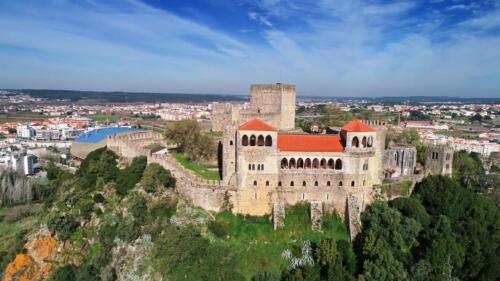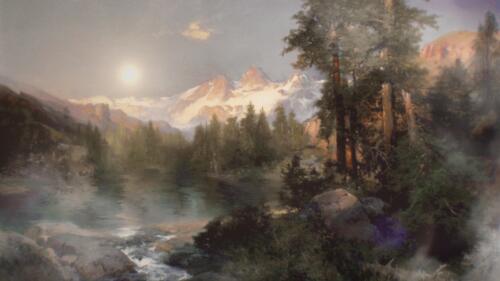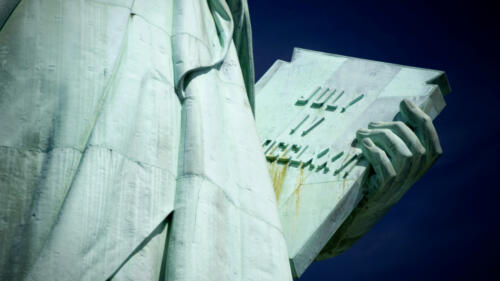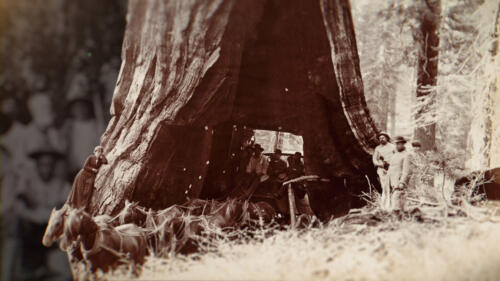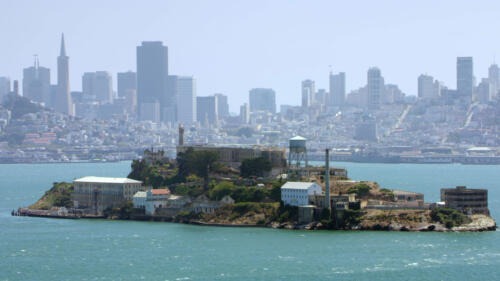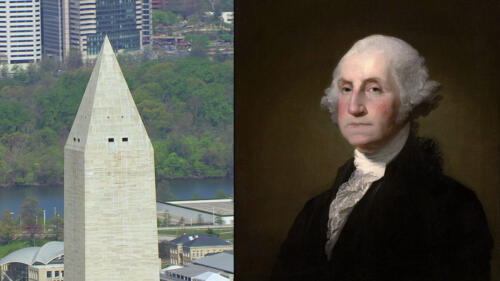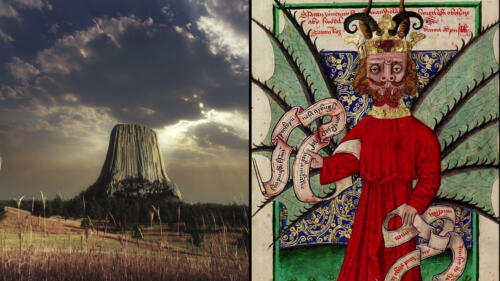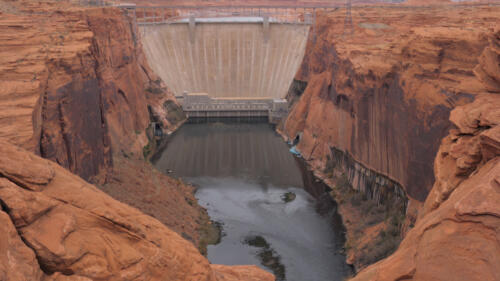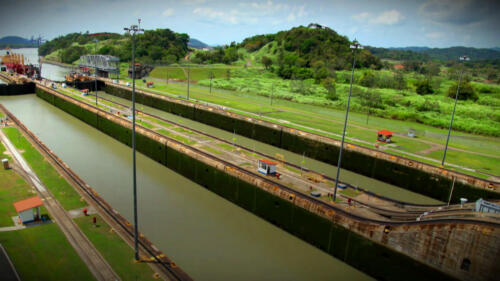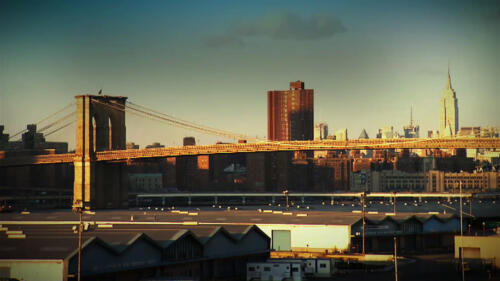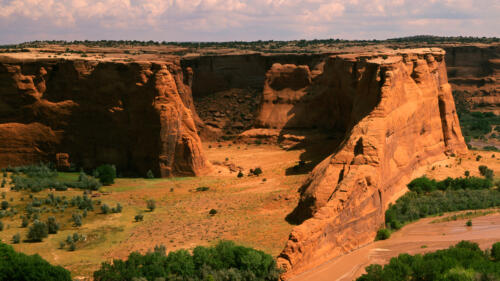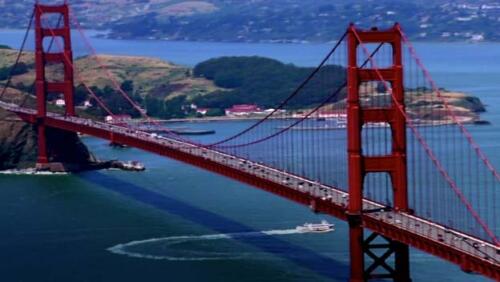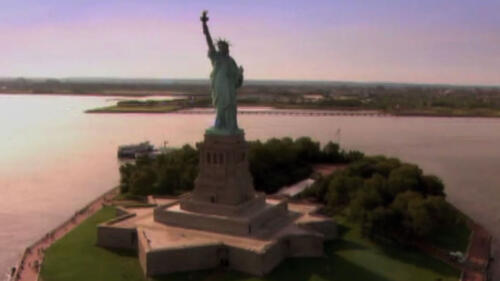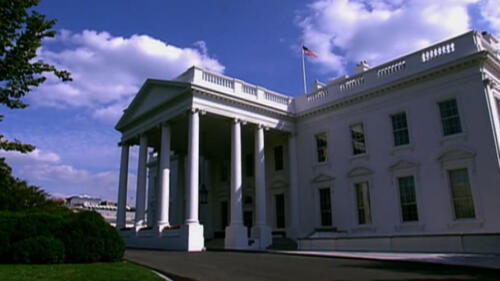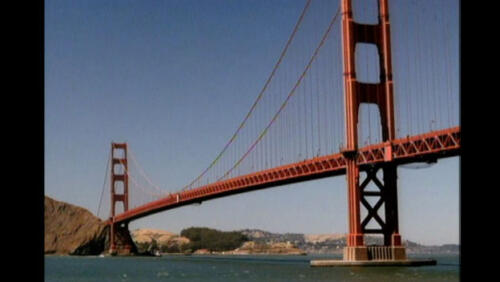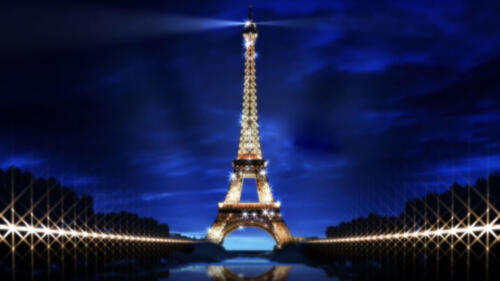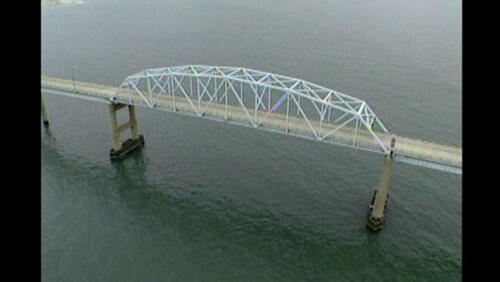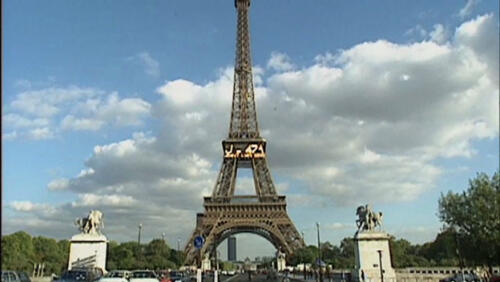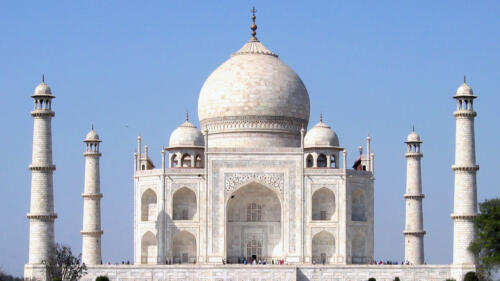Landmarks
Landmarks include spectacular monuments such as the Eiffel Tower, Mount Rushmore, the Panama Canal and the Brooklyn Bridge. They can also include awe-inspiring natural structures including Mount Everest, the Grand Canyon and Niagara Falls.
Featured Overview
You might know that the Statue of Liberty was built in France, but how exactly did they move the 225-ton icon to the United States?
1:01m watch

Getty Images
Featured Overview
You might know that the Statue of Liberty was built in France, but how exactly did they move the 225-ton icon to the United States?
1:01m watch
Start Here

A gold prospector dubbed the peak Mount McKinley in 1896, but Alaskans have historically championed Denali, a name rooted in its Native American history.

After her husband was incapacitated in an accident, Emily Warren Roebling took over supervising the complex construction of the landmark.

These remarkable feats of design and construction transformed the ways people travel, communicate and live.

A little-known chamber concealed behind the head of Abraham Lincoln was intended to contain a shrine to America.
How Devil’s Tower Got Its Name
How Devil's Tower Got its Name
Devil's Tower is one of the most recognizable features of the American landscape, but not everyone agrees on what it should be named.
1:02 watch

3 Iconic New York City Buildings
Explore All Related Topics

These iconic structures showcase the sleek geometry and lavish detail that defined early 20th-century architecture.
For millennia, Stonehenge has amazed and confounded visitors and archaeologists alike. The massive awe-inspiring circle of stones was obviously important to its prehistoric builders. But what is it for? How did they build it? And why?
5:25m watch

After opponents decried the tower's appearance for 'disregarding French taste,' Gustave Eiffel installed some key scientific devices at the top to give it purpose and ensure its survival.
Yellowstone National Park became the world's first national park on March 1, 1872, when President Ulysses S. Grant signed the Yellowstone National Park Protection Act into law.
1:00m watch

Humans have a long history of capturing the passage of time by tracking the position of the sun.

U.S. place names are rooted in Indigenous languages, physical characteristics and honorifics for politicians and pioneers—and they can be controversial.
John Frank Stevens engineered one of the greatest engineering wonders of the world, the Panama Canal, but he had to overcome many challenges along the way.
9:59m watch
Boston and New York City compete to build the first subway system, which sends ripples through the mass transit system forever.
7:59m watch

After a tense lead-up, treaties signed in 1977 paved the way to ending American management of the 51-mile-long waterway.

A gold prospector dubbed the peak Mount McKinley in 1896, but Alaskans have historically championed Denali, a name rooted in its Native American history.

The monument's colorful history includes a fraudulent bond election, a mistaken design competition winner—and a civil rights protest in the sky.

The Mariana Trench remained undiscovered until a crew from the HMS Challenger unsuspectingly lowered a weighted rope into its immense depths.

Building New York City's 843-acre park involved sledgehammers, pickaxes, gunpowder and thousands of plantings. The project also forced out a community of African American residents.

The longest cave system winds for more than 400 miles, but others on the list haven't even been fully explored yet.

In 1934, wind gusts of 231 miles per hour roared over the top of Mount Washington, rattling the weathermen who managed to record it.

A single giant sequoia could supply 500,000 board feet of lumber, a bonanza for profit-hungry logging companies—or so it was thought.

When it opened in 1926, the St. Francis Dam was an engineering marvel. Just two years later, it became an engineering catastrophe.

Workers completed the 102-story, Art Deco-style landmark in an astonishing one year and 45 days.

For five months in 1969, water flowing to the New York side of Niagara Falls was diverted, leaving a 100-foot-high dry cliff.

From remnants of a once-glorious station to mysterious depictions of beavers, the NYC subway holds many secrets.

Wright designed the iconic home perched over a waterfall in 1934 as a full realization of what he called "organic architecture."

Only five U.S. lakes, most of them in the mountainous West, descend more than 1,000 feet into the watery depths.
Frédéric Auguste Bartholdi was on the cutting edge of a new construction technique while constructing the Statue of Liberty and had to overcome many engineering obstacles.
9:58m watch
Frédéric Auguste Bartholdi was on the cutting edge of a new construction technique while constructing the Statue of Liberty and had to overcome many engineering obstacles, in this clip from Season 1, "Liberty Rising."
9:58m watch

After her husband was incapacitated in an accident, Emily Warren Roebling took over supervising the complex construction of the landmark.
Colonel Charles Young overcame racism to rise through the ranks and create his legacy in the great outdoors.
1:00m watch

Yellowstone's stunning natural beauty inspired the 19th-century push to set aside the land, where Indigenous people had been present for millennia.

Discover the secrets—and myths—within New York City's Grand Central Terminal, which first opened on February 2, 1913.

Rejected designs include an Egyptian-style pyramid. And his hand gestures have symbolic meaning.

Although France paid for the statue, the US had to pay for the pedestal.

From nourishing agricultural soil to serving as a transportation route, the Nile was vital to ancient Egypt's civilization.
The White House is one of the great patriotic symbols of America, but its construction history gets into the darkest parts of the nation's past.
1:01m watch
You might know that the Statue of Liberty was built in France, but how exactly did they move the 225-ton icon to the United States?
1:01m watch
A camping trip in 1903 might be the most influential in history! John Muir and Teddy Roosevelt spent three nights in Yosemite. Muir would convince Roosevelt to protect Yosemite, paving the way for a National Park Service.
1:02m watch
Alcatraz is one of the most notorious prisons in American history, but did it really live up to its feared reputation?
1:02m watch
The Washington Monument is one of the most iconic structures in the United States, but its construction wasn't always a sure thing.
1:02m watch
Devil's Tower is one of the most recognizable features of the American landscape, but not everyone agrees on what it should be named.
1:02m watch
The Hoover Dam, one of America's greatest engineering achievements, was almost destroyed by the Nazis during WWII.
1:02m watch

Horrific workplace accidents claimed a string of lives and left its designer dead and his son crippled.

The 1.7-mile-long bridge has endured earthquakes, lead paint and record crowds since its historic construction in 1937.

It took grassroots efforts to raise the funds and ultimately build the colossal monument in New York Harbor that has come to symbolize freedom around the world.

From the early step pyramids to the towering Great Pyramids of Giza, the tombs are among the few surviving wonders of the ancient world.

Dissent at or inside the statue began with its unveiling in 1886.

Michigan Central Station was once the tallest train station in the world. Then as Detroit fell on hard times, so did its train hub. Can its rebirth help revitalize Motor City?

New analysis of an ancient site gives man’s oldest friendship an even earlier start date.

Jesse Hawley Beginning in 1807, Jesse Hawley—a flour merchant from western New York who went broke trying to get his product to market in the Atlantic coastal cities—published a series of essays from debtor’s prison. In them, Hawley advocated for a cana...

UNESCO World Heritage Site In 1984, the Alhambra was designated a UNESCO World Heritage Site along with two other related sites: the Albaicín (or Albayzín) and the Generalife Garden. The Alhambra is located west of the city of Granada on the Sabika hill...

Angkor Wat, a Cambodian Buddhist temple complex considered the largest religious monument in the world, was built in the 12th century by Emperor Suryavarman II.

Sinagua Indians The Sinagua—peaceful, pre-Colombian Native Americans—were hunter gatherers and farmers who grew mainly corn, squash and beans. Their exact origin is unclear. Recovered Sinagua artifacts have shown they were simple people yet gifted craft...

Where Is Mount Vernon? Mount Vernon is located in Mt. Vernon, Virginia, overlooking the Potomac River about eight miles south of Alexandria. It’s unclear who designed the original estate home on the site, but George Washington oversaw its many expansion...

Library of Congress Founded The story of the Library of Congress began in 1800, when President John Adams approved a congressional act that moved the national capital from Philadelphia to Washington, D.C. As part of that bill, a sum of $5,000 was earmar...

The 111-year-old law allowed President Trump to shrink two Native American cultural sites.

The Nazca Lines are a collection of ancient geoglyphs, many of which depict giant plants, animals and shapes, that line the coastal plain south of Lima, Peru.

Serpent Mound is the world’s largest surviving effigy mound—a mound in the shape of an animal—from the prehistoric era. Located in southern Ohio, the 411-meter-long (1348-feet-long) Native American structure has been excavated a few times since the late 1800s, but the origins of Serpent Mound are still a mystery. Some estimates place the construction of the National Historic Landmark—also called Great Serpent Mound—at around 300 B.C.

Arlington National Cemetery is a U.S. military cemetery in Arlington, Virginia. The site, once the home of Confederate Army commander Robert E. Lee, is now the burial ground for more than 400,000 active duty service members, veterans and family members.

Westminster Abbey, one of the most famous religious buildings in the world, has hosted British royal coronations, marriages and burials since the 11th century.

Buckingham Palace was built in the early 1700s before becoming the official British royal residence with the ascencion of Queen Victoria the following century.

From a 'bear lunch counter' to a less-than-faithful Old Faithful, here are some surprising things to know about America’s first national park.

From ancient hideouts to Cold War-era bunkers, explore eight astonishing settlements beneath the Earth’s surface.

In 1852 the British-sponsored Great Trigonometrical Survey, which had been mapping the Indian subcontinent since the early 1800s, identified the highest mountain in the world straddling Nepal and Tibet in the Himalayas. The British initially referred to the 29,035-foot-tall pinnacle as Peak XV until Andrew Waugh, the surveyor general of India, proposed that it be […]

A little-known chamber concealed behind the head of Abraham Lincoln was intended to contain a shrine to America.

In 1968, an American tycoon bought London Bridge—all 10,000 tons of it—and moved it brick-by-brick to the desert town of Lake Havasu City, Arizona.

From an 11,000-year-old temple complex to a mystifying Irish megalith, here are seven lesser-known world wonders that stand as a testament to the engineering prowess of the ancients.

Get the story behind Dwight Eisenhower’s grueling, 62-day cross-country road trip that inspired the creation of the Interstate Highway System.

Check out 10 little-known facts about one of the United States’ most iconic skyscrapers.

The origins of Chicago’s famous nickname are not entirely clear. The most obvious explanation is that it comes from the frigid breezes that blow off Lake Michigan and sweep through the city’s streets. However, another popular theory holds that it was coined in reference to Chicago’s bloviating residents and politicians, who were deemed to be […]

Check out 10 surprising facts about the UNESCO World Heritage Site.

In 1915, Cecil Chubb went to an auction to buy some dining chairs but returned home with the ultimate impulse buy—Stonehenge.

Get the facts on this engineering marvel, which was dedicated in September 1930.

The Panama Canal is a massive engineering marvel that connects the Pacific Ocean with the Atlantic Ocean through a 50-mile series of shipping canals and locks.

The Great Sphinx of Giza, a giant limestone figure with the body of a lion and the head of a man wearing a pharaoh’s headdress, is the national symbol of Egypt—both ancient and modern—and one of the world’s most famous monuments. Despite its iconic status, geologists, archaeologists, Egyptologists and others continue to debate the Sphinx’s […]

Construction on the White House began in the 1790s. The official home for the U.S. president was designed by Irish-born architect James Hoban but has evolved with the personal touches of its residents and accommodated such technological changes as the installation of electricity and a personal movie theater.

The Golden Gate Bridge, opened in 1937, is an iconic suspension bridge connecting the city of San Francisco to Marin County, California. It spans almost two miles across the Golden Gate, the narrow strait where San Francisco Bay opens to meet the Pacific Ocean.

Among the waterways linking the lakes are the St. Marys River, the Niagara River, and the narrow Straits of Mackinac.

From Pullman, Illinois, to Hershey, Pennsylvania, learn about life in towns built and once controlled by a single company.

Explore 10 surprising facts about the island nation.

10 surprising facts about the Paris icon.

Discover some surprising facts about the Japanese capital.

Berlin’s triumphal arch has played witness to some of the most significant moments in modern history.
Hailed as one of the great achievements of the 20th Century, the Panama Canal connects 160 countries and 1,700 ports around the world.
2:09m watch

Explore some surprising facts about the highest mountain in the world.
One of New York’s most famous landmarks, the Brooklyn Bridge transports 120,000 vehicles and 4,000 pedestrians every day.
1:56m watch

One of America’s first “rural” cemeteries has been welcoming New Yorkers since 1838.
Explore the geological history of the Grand Canyon, one of the Seven Natural Wonders of the World.
1:37m watch

One of the nation’s most celebrated schools has announced a controversial change to its tuition structure.

Theories run the gamut, casting Stonehenge as anything from an ancient healing center to an alien landing site.

Here are 10 unusual facts about the New York City landmark.

Barrel plunges, tightrope walks and jet skis—Niagara Falls has seen a plethora of daring stunts.
Get the facts about one of the world's most beautiful bridges.
3:23m watch
How many steps are there to the crown of the Statue of Liberty? Find out that and other facts and figures about America's most recognizable symbol of freedom.
1:29m watch
It may not have been home to the president until 1800 or even called the White House until 1901, but it remains a symbol of freedom and democracy throughout the world.
1:36m watch
Why did some people initially think the Golden Gate Bridge was a dangerous idea?
4:07m watch
Originally intended as a temporary installation, the Eiffel Tower has become one of the most enduring symbols of France and the industrial age.
2:16m watch
Stretching 17 miles across the historic Chesapeake Bay, the Chesapeake Bay Bridge is a mammoth engineering feat. How long did the iconic bridge take to complete?
4:17m watch
What do the Eiffel Tower and the Statue of Liberty have in common?
3:12m watch
The Eiffel Tower was originally not well-liked by Parisians, but over time, it has become an iconic symbol of the city.
2:53m watch
The Taj Mahal is a marvel of engineering that was built as a mausoleum for the wife of Mughal emperor Shah Jahan.
3:52m watch

Arlington National Cemetery has been the focal point of national Memorial Day commemorations since 1868.

As San Francisco's Golden Gate Bridge celebrates its birthday, explore six surprising facts about this modern marvel of engineering.

With the announcement of a $1 billion public stock offering, it will soon be possible to own a piece of one of the world's most iconic buildings.

The executive mansion has come under fire multiple times through history.

Built for the 1889 World's Fair in Paris, the Eiffel Tower is a 1,000-foot tall wrought iron tower, considered an architectural wonder and one of the world's most recognizable structures.

The mystery of how prehistoric builders constructed the mighty Stonehenge has baffled scholars for centuries.

The First Monticello Born on April 13, 1743, Thomas Jefferson grew up at Shadwell, one of the largest tobacco plantations in Virginia. At the age of 21, he inherited several thousand acres of land that encompassed the family estate as well as his favori...

Background Drought hit the Los Angeles region in the first years of the 20th century, highlighting an urgent need to find a better, more consistent water supply if city leaders were to transform the city into a major West Coast metropolis. Through the e...

Spindletop was an enormous geyser of oil that exploded from a drilling site at Spindletop Hill, a mound located in southeastern Texas, in 1901. Reaching a height of more than 150 feet and producing close to 100,000 barrels a day, the “gusher” was more powerful than any previously seen in the world. A booming oil industry soon grew up around the oil field.

Plans for Construction Though the Flatiron Building is often said to have gotten its famous name from its similarity to a certain household appliance, the triangular region contained by Broadway, Fifth Avenue, and 22nd and 23rd Streets had in fact been ...

A New Design Following the Great Chicago Fire of 1871, a boom of new construction would revitalize the city’s economy and completely transform its skyline. Instead of wood, the new buildings going up in Chicago were made largely of stone, iron and steel...

Building the World’s Tallest Building Retailer Frank W. Woolworth commissioned his namesake building in 1910, a year after the Metropolitan Life Insurance Company moved into their 700-foot tower on Madison Square, just a block away from the triangle-sha...

The Brooklyn Bridge, which connects the New York City boroughs of Brooklyn and Manhattan, was constructed between 1869-1883 and spans 1,595 feet.

Niagara Falls—comprised of three waterfalls: American Falls, Horseshoe Falls and Bridal Veil Falls—is not only one of most popular tourist attractions in upstate New York but also functions as one of the major power providers to the state. The water from Niagara Falls stems from the upper Great Lakes and the river is estimated to be 12,000 years old.

The iconic twin towers of downtown Manhattan’s World Trade Center were a triumph of human imagination and will. The attacks on the towers on 9/11 destroyed lives and radically altered the skyline of New York City, destroying the twin columns of glass and steel that over the years had come to embody the city itself.

The Statue of Liberty was given to the United States by France, as a symbol of the two countries' friendship. It was erected atop an American-designed pedestal on a small island in Upper New York Bay, now known as Liberty Island, and dedicated by President Grover Cleveland in 1886.

Where Is the Grand Canyon? The Grand Canyon is located in northern Arizona, northwest of the city of Flagstaff. The canyon measures over 270 miles long, up to 18 miles wide and a mile deep, making it one of the biggest canyons in the world. This natural...




